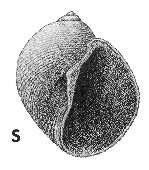
Revised descriptions of New Zealand Cenozoic Mollusca from Beu and Maxwell (1990)

 | Revised descriptions of New Zealand Cenozoic Mollusca from Beu and Maxwell (1990) | 
|
  (Pl. 47s): GS5833, Y14/f7505, Te Piki, Cape Runaway, near East Cape, Haweran (oxygen isotope stage 7) (GNS) |
Beu & Maxwell (1990): Chapter 16; p. 352; pl. 47 s.
Synonymy: Nerita papilla Gmelin 1791, p. 3675; Sigaretus linnaeanus Récluz 1843, p. 8; Sigaretus lamarckianus Récluz 1843, p. 7; Sigaretus (Naticina) cinctus Hutton 1885b, p. 318; Eunaticina cincta; Pervisinum dingeldeii Iredale 1931, p. 216; Eunaticina linnaeana, Beu & Maxwell 1990, p. 352, pl. 47s; Eunatica papilla, Beu 2004, p. 206, fig. 22D-F, H.
Type species of Eunaticina Fischer, 1885
Classification: Naticidae: Poliniceinae
Description: Small for family (18-20 mm high), regularly oval, with small, pointed spire and large, long last whorl with evenly rounded anterior; thin and fragile. Inner lip only lightly thickened; umbilicus deep, widely open to relatively narrow, conical, without funicle. Sculpture of many low, wide, square-edged, widely spaced spiral cords, cord surfaces and interspaces equally crowded with fine spiral threads; all crossed by relatively prominent, narrow axial ridges, serrating edges of spiral cords, and raised into prominent axial ridges and folds over last half-whorl of large specimens. Protoconch very low, of about 2 polished, apparently smooth whorls, not clearly differentiated from the teleoconch.
Comparison: Before Beu & Maxwell (1990), no close relationship had been recorded between Eunaticina cincta and any modern Indo-West Pacific species. Finlay & Marwick (1937, p . 55) pointed out that "Pervisinum" dingeldeii Iredale, 1931 (Recent, eastern Australia) appears to belong in Eunaticina, and comparison of specimens of the New Zealand fossil and Australian living populations (with B.A. Marshall, National Museum of N.Z.) showed that they have identical protoconchs, teleoconch and umbilicus shape, and range of variation in teleoconch sculpture. Kilburn (1976, p. 870) thought that the earliest name for this species was Eunaticina linnaeana (Récluz, 1843), and this name was adopted by Beu & Maxwell (1990, p. 352) for the New Zealand species. However, Beu (2004, p. 206) demonstrated that E. papilla is an earlier name for the same species, and provided a detailed synonymy. Other modern specimens occur from Japan and Fiji to Natal and Mozambique. This species is highly distinctive in the New Zealand fauna because of its moderately tall spire, thin shell, uniform shallow spiral grooves over the entire exterior, and open umbilicus without a funicle.
Distribution: Haweran (-Recent?); Landguard Sand, Landguard Bluff, east of Wanganui River mouth, Haweran (oxygen isotope stage 9) (type of S. cinctus); very rare in the Landguard Sand at Wanganui (only the type and 1 other specimen known), uncommon (about eight specimens seen) in the Te Piki member, near East Cape, Haweran (oxygen isotope stage 7); also one stained Recent(?) specimen recorded from the Bay of Islands (Powell 1979, p. 158) but its status in the Recent fauna is unknown.
Cite this publication as: "A.G. Beu and J.I. Raine (2009). Revised
descriptions of New Zealand Cenozoic Mollusca from Beu and Maxwell (1990). GNS
Science miscellaneous series no. 27."
© GNS Science, 2009
ISBN
978-0-478-19705-1
ISSN 1177-2441
(Included with a PDF facsimile file
copy of New Zealand Geological Survey Paleontological Bulletin 58 in CD version
from: Publications Officer, GNS Science, P.O. Box 30368 Lower Hutt, New
Zealand)